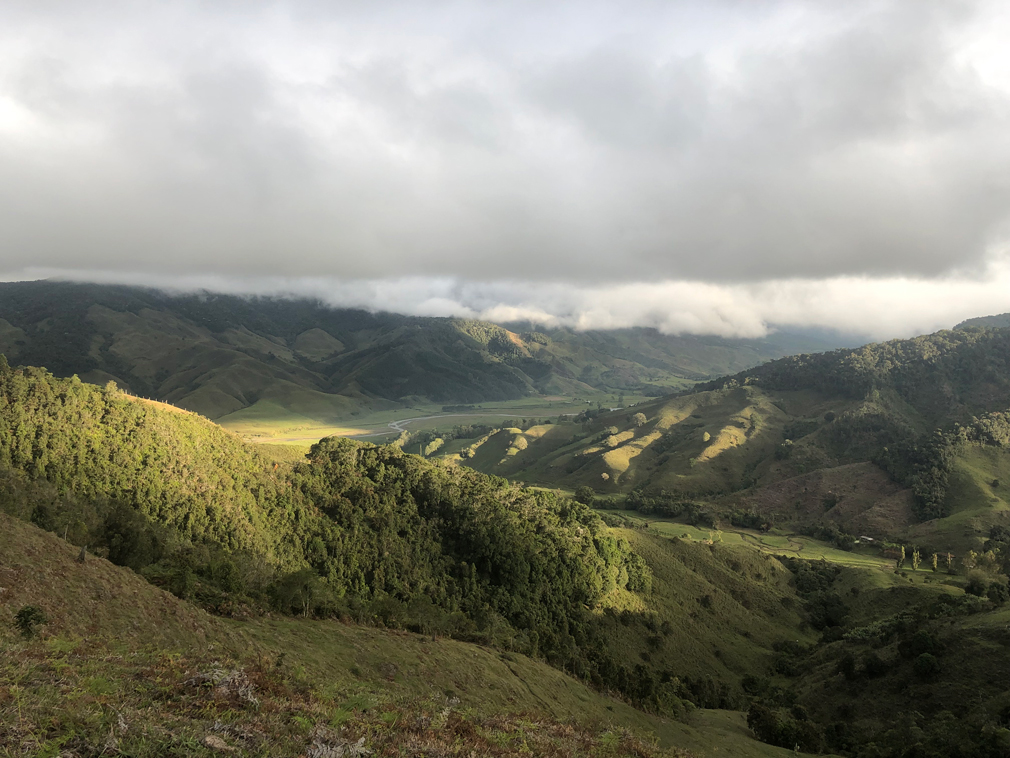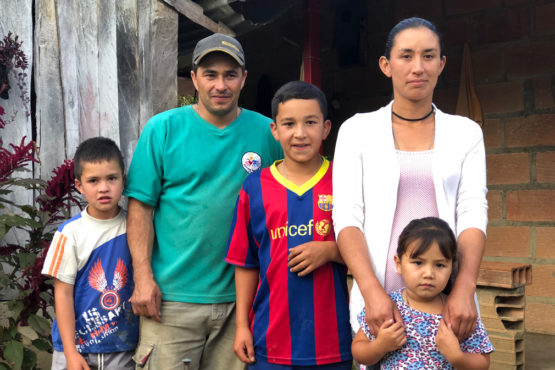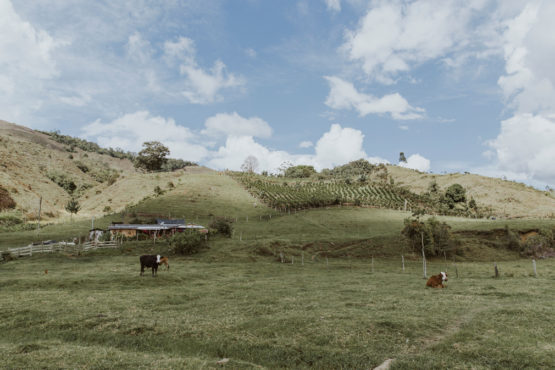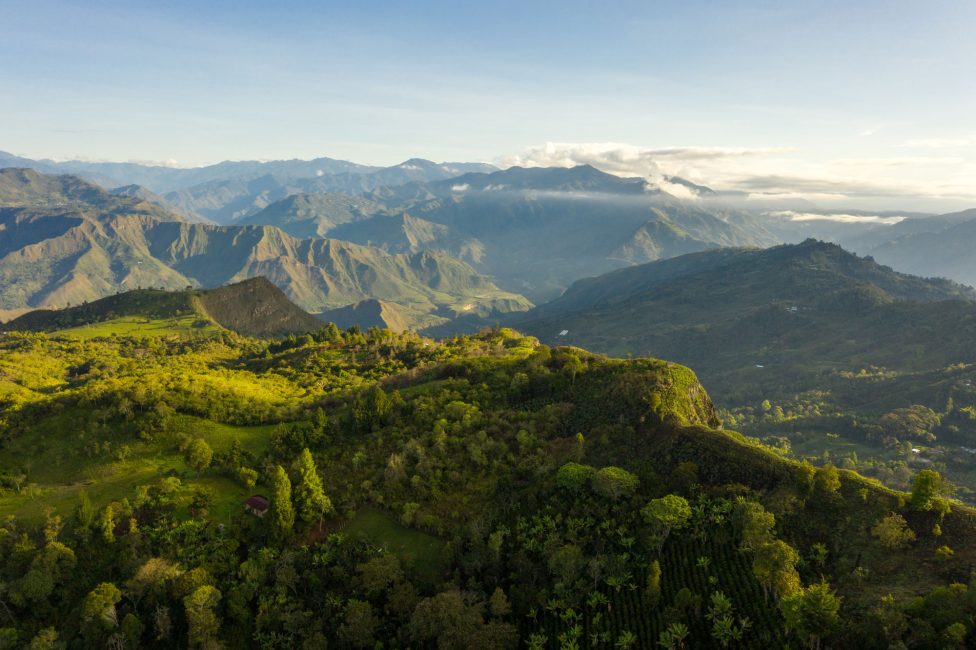La Despensa Chiroso
Very complex, with vibrant apricot, plum and melon and a distinct pineapple acidity. Sweet, juicy and clean.
This 100% Chiroso lot was grown and processed by six smallholder producers that are situated in the small valley of La Despensa, part of the Urrao region, located in the high mountains of Western Antioquia, Colombia. The producers are Fray David, Yessica Moreno, Luis Alvaro Vargas, Pablo Emilio Monteya, Leonardo Henao and Linderman Moreno.
Urrao is a unique and special coffee growing region, located in the valley of Rio Penderisco, at around 1900m above sea level. Unlike other producing regions in Colombia, which are characterised by deep canyons and massive, rugged mountains, Urrao is covered in rolling green hills, calm pastures and beautiful rivers that snake through the landscape. This geography guarantees cool temperatures year-round, typically only reaching between 12-25 degrees. This cool climate is ideal for the slow ripening of coffee cherries, leading to denser beans and a sweeter, more complex cup profile.
Until recently Urrao was overlooked as a coffee-producing region and dismissed by many as being too cold for good production. There is still very little coffee produced in the area, despite it being some of the most fertile land in Antioquia. Many farmers complement the income they make from coffee by growing lulo, a type of passionfruit that tastes similar to a kiwi fruit and that is incredibly popular in Colombia. Coffee grown in Urrao is slowly becoming recognised and sought after for the high quality and complexity of coffees produced here.
La Despensa is one of many different small valleys that run through the region, merging into Valle de Penderisco. This small area is named for the creek that runs through it, with about a dozen small farms situated alongside the water. La Despensa means “pantry” and the valley is aptly named; the area is abundantly fertile, with coffee, lulo, other fruits, vegetables and livestock thriving here.
Many of the farmers whose coffees make up this lot abandoned coffee production when prices hit unsustainable lows. Now, with access to specialty buyers through our supply partner Pergamino, quality-focused coffee production can be a profitable crop. Most farmers have chosen to plant Chiroso, a long bean coffee variety which has become recognised for its exceptional quality. Chiroso is native to the area and is most likely a mutation of the Caturra variety, which has been historically planted in this area. Originally cultivated for its resilience to the cool climate of Urrao, it is now being celebrated for its complex and floral cup profile, which attracts higher premiums from specialty buyers. Coupled with the slow fermentation process typical to Urrao, this variety is resulting in some outstanding coffee lots and bringing international attention to this micro-region of Colombia.
The farms that contributed to this lot are very small – just 1 hectare on average – and are traditionally farmed. Fertilisation occurs around three times a year, usually after manual weeding, and pesticides are rarely used. The coffee is selectively hand-harvested, with most labour being provided by the farmers and their families.
ABOUT ANTIOQUIA
Antioquia is located in central North-Western Colombia. Coffee was introduced to the region in the latter part of the 19thcentury. Since then, this mountainous, fertile department has 128,000 hectares of coffee that is produced by a mix of large estates and tiny farms.
Antioquia only recently became more accessible to specialty coffee buyers – largely thanks to a transformation of the department led by Sergio Fajardo, who was the governor of the department in 2012-2016. Sergio transformed Antioquia’s capital city, Medellín, from a violent and dangerous place to a world-class tourist destination with a strong economy. Coffee has played a significant role in this transformation, and as access to many producers has improved, the region has become one of Colombia’s most important and celebrated coffee-producing areas.
HOW THIS COFFEE WAS SOURCED
This coffee is sourced by our export partners, Pergamino, who work with over 50 small, independent farmers in and around the town of Urrao. Pergamino has done a lot to help promote commercialisation of specialty coffee throughout Antioquia and have actively been working to source and support coffee producers in regions where there is a high potential for quality, but that historically have not had access to specialty buyers.
During harvest, farmers deliver small lots (around 100-150kg) of dried parchment to Pergamino’s warehouse every 2-3 weeks. Upon delivery, a sample of the dried parchment is milled and assessed for physical attributes, including uniformity of size, presence of defects, moisture content and seed to hull ratio. If the coffee passes the physical assessment it is accepted and the farmer receives their first payment for the coffee, calculated by the weight delivered and a base rate related to the physical quality of the parchment.
The coffee is then cupped and assessed for sensory attributes. After being accepted locally the coffees are transported to Pergamino’s QC lab in Medellin, where they are further assessed by an expert team of cuppers. Each lot is carefully evaluated and, based on the cup score and profile, the coffee is sorted into different grades of quality and combined into exportable sized lots. Feedback on each lot is relayed back to the producer and after it has sold a second payment is made to the producer according to premium the coffee attracted. Coffees like this special Chiroso micro-lot represent the very highest quality and receive the best premiums.
The team at Pergamino cups through hundreds of small lots from La Despensa at their QC lab in Medellin, to select the coffees that are blended together into this special, single variety micro-lot. The coffees included were chosen for their outstanding cup profile and distinct regional characteristics.
HOW THIS COFFEE WAS PROCESSED
This coffee was selectively hand-harvested, with most labour being provided by the producers’ families. The coffee was processed using the washed method at each farm’s ‘micro-beneficio’ (mill).
The coffee was pulped using a small manual or electric pulper and then placed into a fermentation tank. Because of the cooler climate in Urrao, producers here tend to ferment the coffees for longer than usual and will often blend several days’ worth of pickings over a 3-5 day period. Every day, freshly picked cherry is pulped and added to the mix, which lowers the pH level and – along with the cooler temperatures – allows for an extended fermentation process. This fermentation process contributes to a vibrant, winey acidity in the coffee’s cup profile.
The coffee was then carefully dried (over 10–18 days) on parabolic beds, which are constructed a bit like a ‘hoop house’ greenhouse, and act to protect the coffee from the rain and prevent condensation dripping back onto the drying beans. The greenhouses are constructed out of plastic sheets and have adjustable walls to help with airflow, and temperature control to ensure the coffee can dry slowly and evenly.
Once dry, the coffee was delivered to Pergamino’s warehouse, where it was cupped and graded, and then rested in parchment until it was ready for export.
Read more about our Colombian export partner, Pergamino, here.



